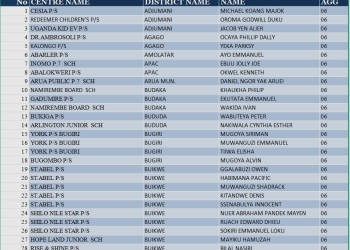
The monthly Stanbic Purchasing Managers’ Index (PMI) dipped slightly during August to 51.6, down from 53.9 recorded in July as businesses took in the implications of the World Bank suspension of further loans to Uganda. However, optimism remains high due to the steady trend of new orders.
August saw a further expansion in output, the thirteenth month running in which an increase has been recorded. Where output rose, the survey respondents cited demand improvements.
Christopher Legilisho, Economist at Stanbic Bank said, “Uganda’s private sector posted a strong performance in August, shrugging off foreign exchange market volatility after the World Bank suspended project support. Private sector activity increased in August, albeit at a slower pace than in the preceding months, as respondents reported higher demand and robust new orders.”
On the other hand, there were some reports of financial pressures in the economy restricting growth. Activity increased in the construction and services categories, but decreased in agriculture, industry and wholesale and retail.
The Stanbic PMI is compiled by S&P Global from responses to questionnaires sent to purchasing managers in a panel of around 400 private sector companies. The sectors covered by the survey include agriculture, mining, manufacturing, construction, wholesale, retail and services.
The PMI is a weighted average of the following five indices: New Orders (30%), Output (25%), Employment (20%), Suppliers’ Delivery Times (15%) and Stocks of Purchases (10%).
Readings above 50.0 signal an improvement in business conditions on the previous month, while readings below 50.0 show deterioration.
As was the case with output, new orders rose again midway through the third quarter of the year. A number of respondents indicated that the securing of new customers had helped to drive up order volumes. Customer numbers and client demand are expected to improve further during the remaining months of the year.
Legilisho said, “Firms remained upbeat about business prospects, therefore further ramping up employment, inventories and purchasing activity in response to new orders. The only notable downside in August was the deterioration in export orders. However, prices of inputs rose in August, pointing to higher costs for a range of goods and services as well as staff costs. Interestingly, though, some firms reduced charges to stimulate demand because financial pressures have been mounting in Uganda’s economy.”
Companies posted another monthly increase in stocks of purchases in August. Inventories have now risen in each of the past 10 months. Exactly 19% of respondents expanded their stocks of purchases, against 11% that reduced them.
August data pointed to a further monthly rise in overall input costs in the Ugandan private sector, with input prices now having increased in 25 consecutive months. Respondents often mentioned higher charges for electricity and water. All five monitored sectors saw overall input costs rise in the latest survey period.
Higher purchasing helped firms to expand their inventories of inputs, although issues accessing materials caused delays to the delivery of items by suppliers. Input costs rose again amid increases in expenses for purchased items, staff and utilities. Anecdotal evidence pointed to higher costs for a range of items, including cement, food, paper and stationery.
In turn, companies also raised their own selling prices, although some firms indicated that competitive pressures and efforts to stimulate demand led them to offer discounts. Four of the five monitored sectors posted increases in selling prices, the exception being agriculture.
August data pointed to a fifth successive monthly rise in employment in the Ugandan private sector as firms responded to higher new orders by taking on additional staff. Workforce numbers increased in the agriculture, industry, service and wholesale and retail sectors, but decreased in construction.
As has been the case throughout the history of the series so far, backlogs of work decreased in August. For the first time since February, all five broad sectors covered by the survey posted a reduction in outstanding business
Companies remained optimistic that output will increase over the coming year, with 88% of respondents forecasting growth. Firms generally expect greater customer numbers and improving demand to support an expansion in activity.




















